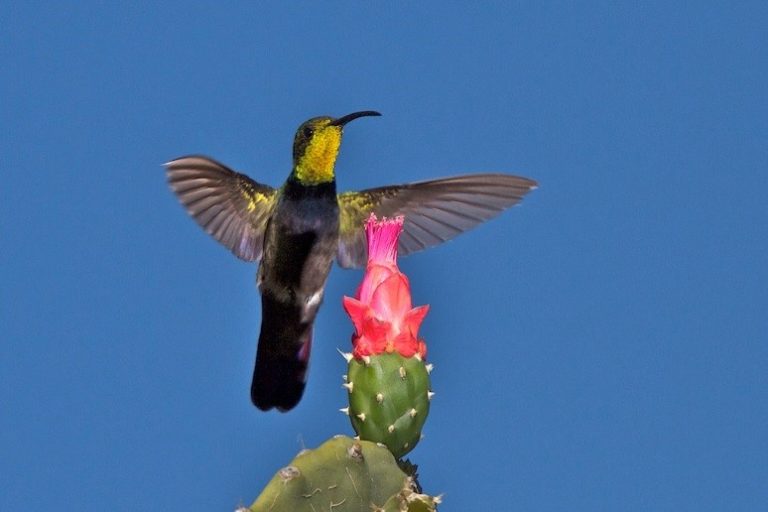Birdfinding.info ⇒ Common and easy to find across most of Puerto Rico. Most reliably found in the southwest at Cabo Rojo National Wildlife Refuge, La Parguera, and Guánica State Forest. Can be found in the gardens of many seaside resorts and in urban areas, including San Juan.
Puerto Rican Mango
Anthracothorax aurulentus
Endemic to Puerto Rico and the Virgin Islands.
Inhabits dry forest, scrub and gardens, mainly at low elevations. Numerous in the southern and western coastal lowlands of Puerto Rico, fairly common along the northern coast and in much of the interior, but uncommon to rare in the eastern coastal lowlands.
It has declined and largely disappeared from the Virgin Islands, apparently due to competition with the Green-throated Carib. Puerto Rican Mango was historically known from many of the islands east to Anegada. In recent years, it has been found regularly on Culebra, irregularly on St. Thomas and St. John, and very rarely on other islands.
Identification
A medium-sized hummingbird with a long, decurved bill. Two other hummingbirds of similar size and shape also occur on Puerto Rico: Green Mango and Green-throated Carib. Across most of the area of overlap, one of the three predominates.

Puerto Rican Mango, male. (Mayagüez, Puerto Rico; January 16, 2017.) © Rafy Rodriguez
Male can appear all-dark in poor light, but when well illuminated its upperparts and throat gleam bright greenish-yellow, and its chest deep indigo with green sides.
The male’s lower breast and belly are paler than the chest and the lower belly is usually white.
The central tail feathers are black and bronze and the outer tail feathers are mostly purplish.

Puerto Rican Mango, male. (Guánica State Forest, Puerto Rico; March 20, 2010.) © Rafy Rodriguez
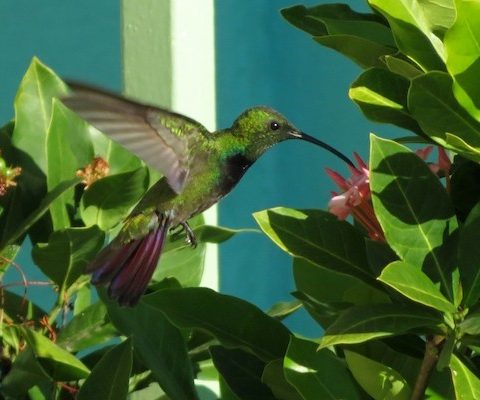
Puerto Rican Mango, male showing dark chest, green sides, and purplish tail. (Cabo Rojo National Wildlife Refuge, Puerto Rico; April 4, 2016.) © Jennifer Marenghi
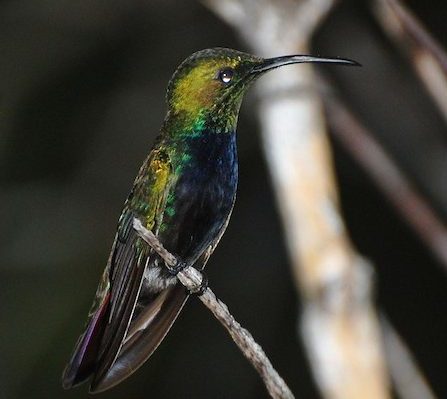
Puerto Rican Mango, male. (Cabo Rojo National Wildlife Refuge, Puerto Rico; December 24, 2014.) © Irina Shulgina
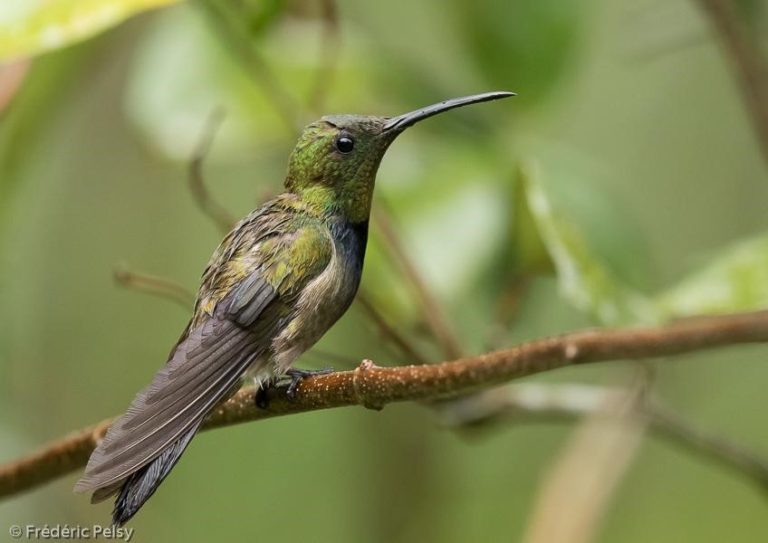
Puerto Rican Mango, male. (Utuado, Puerto Rico; March 21, 2017.) © Frédéric Pelsy
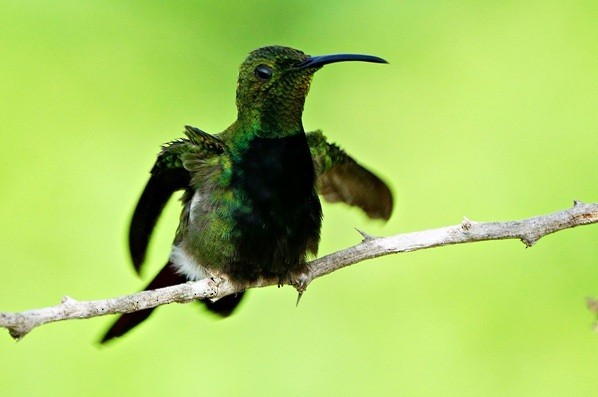
Puerto Rican Mango, male showing green sides. (Lajas, Puerto Rico; March 8, 2019.) © Sadhu Govardhan

Puerto Rican Mango, male. (Rancho Vegas, Cayey, Puerto Rico; March 19, 2017.) © José Santiago
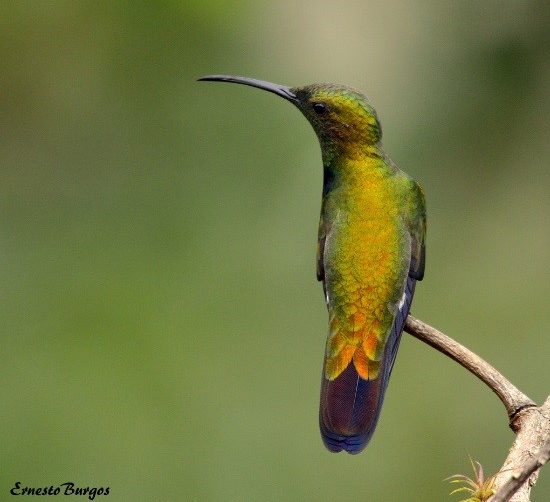
Puerto Rican Mango, male. © Ernesto Burgos

Puerto Rican Mango. (Cabo Rojo National Wildlife Refuge, Puerto Rico; March 3, 2013.) © Ernesto Burgos
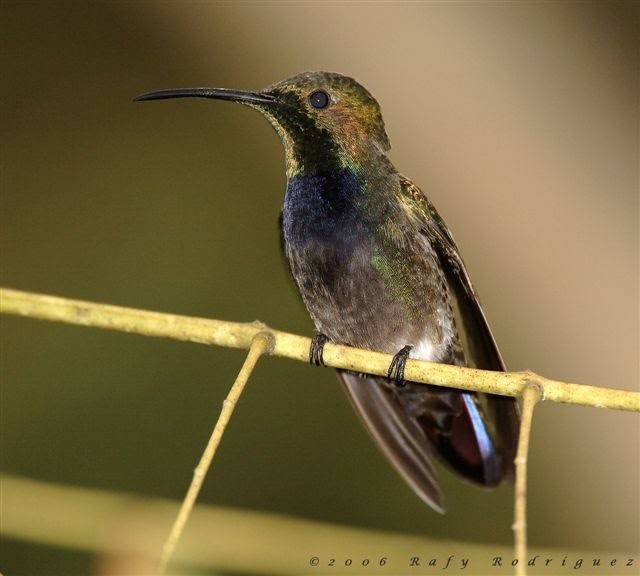
Puerto Rican Mango, male showing indigo chest, sooty lower breast, and paler belly. (Puerto Rico; 2006.) © Rafy Rodríguez
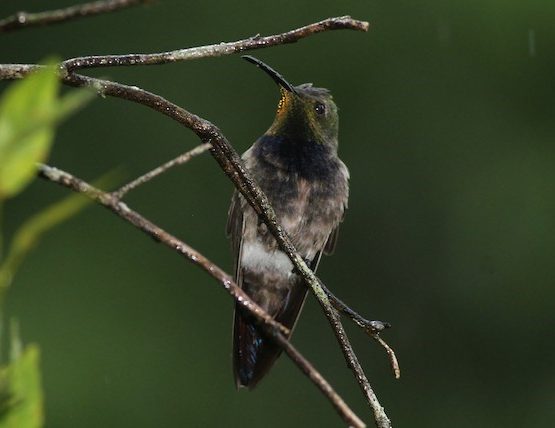
Puerto Rican Mango, male showing indigo chest, sooty lower breast, and paler belly. (Utuado, Puerto Rico; March 21, 2017.) © Alex Lamoreaux
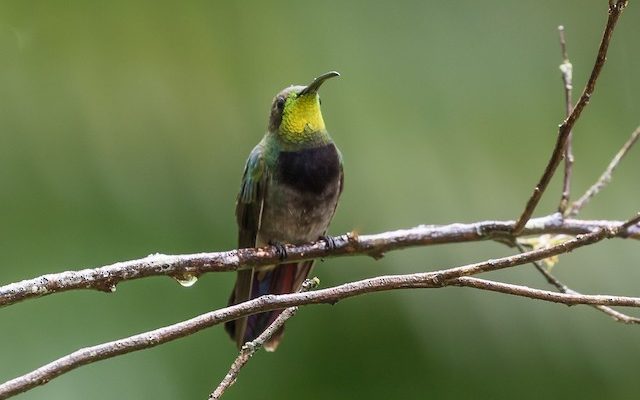
Puerto Rican Mango, male. (Utuado, Puerto Rico; May 26, 2017.) © Chris Sloan
Female has mostly white or whitish underparts, palest on the throat and chest. The sides and flanks are darker, appearing either gray or greenish.
When the tail is folded, the upperside usually appears coppery or greenish. When the tail is spread, the outer feathers show large rusty patches near the base and broad white tips.

Puerto Rican Mango, female showing bronzy uppertail. (Rancho Vegas, Cayey, Puerto Rico; January 7, 2018.) © José Santiago
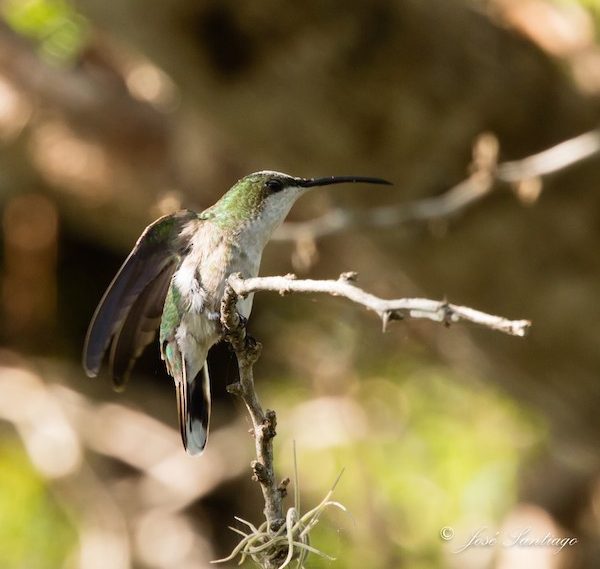
Puerto Rican Mango, female. (Punta Guaniquilla Natural Reserve, Puerto Rico; January 15, 2017.) © José Santiago
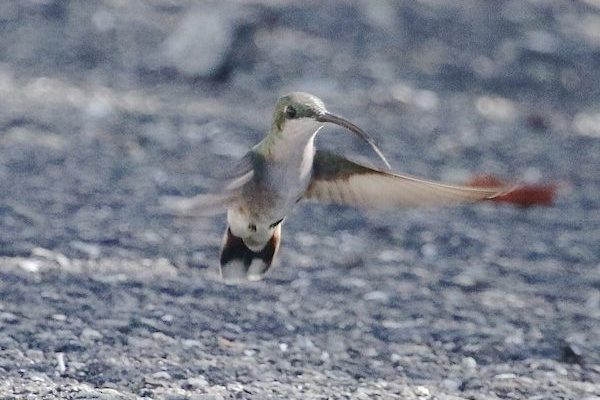
Puerto Rican Mango, female hawking for ants, showing broad white tips on outer tail feathers. (Susúa State Forest, Puerto Rico; March 3, 2017.) © Gil Ewing
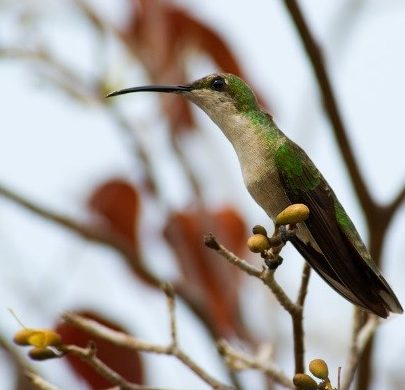
Puerto Rican Mango, female. (Guánica State Forest, Puerto Rico; April 20, 2005.) © Dmitry Mozzheri
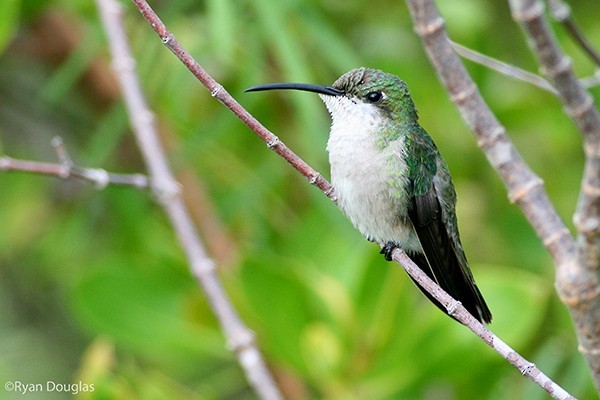
Puerto Rican Mango, female. (Aguirre State Forest, Puerto Rico; January 18, 2008.) © Ryan Douglas

Puerto Rican Mango, female, showing greenish uppertail. (Toa Alta, Puerto Rico; March 24, 2019.) © Ricardo Sanchez

Puerto Rican Mango, female. (Playa Sucia, Cabo Rojo, Puerto Rico; December 25, 2014.) © Irina Shulgina
Immature males resemble females, but the underparts are white with a variable amount of the adult male’s coloration on the throat and extending centrally down the breast. Tail resembles adult male’s, but the outer feathers typically have less extensive purplish patches and narrow white slivers at the tips.

Puerto Rican Mango, immature male. (Rancho Vegas, Cayey, Puerto Rico; August 27, 2017.) © José Santiago
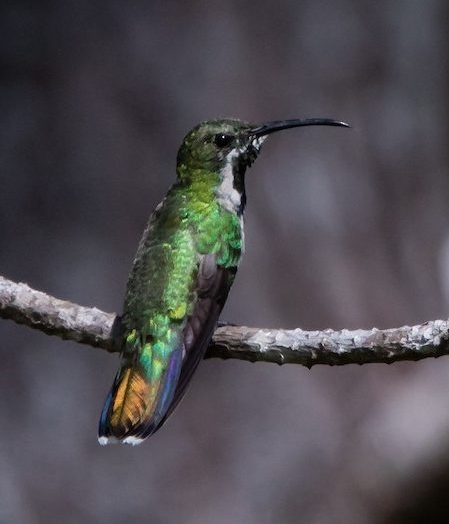
Puerto Rican Mango, immature male. (Rancho Vegas, Cayey, Puerto Rico; April 29, 2018.) © José Santiago

Puerto Rican Mango, immature male. (Rancho Vegas, Cayey, Puerto Rico; May 13, 2018.) © José Santiago

Puerto Rican Mango, immature male. (Cabo Rojo National Wildlife Refuge, Puerto Rico; January 17, 2017.) © Manuel Seda
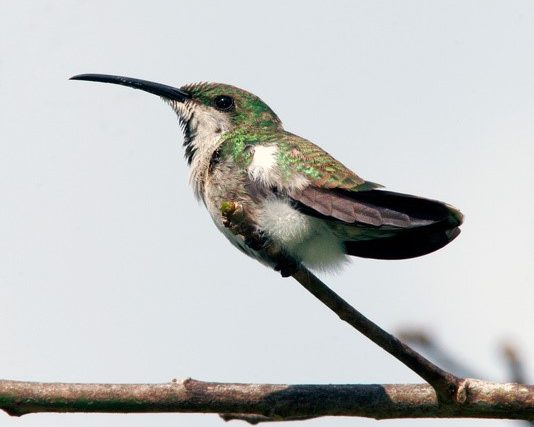
Puerto Rican Mango, immature male. (Puerto Rico; May 13, 2006.) © Alfredo Colón
Cf. Green Mango. Green and Puerto Rican Mangoes overlap mainly in the central hill country. Green generally prefers more humid habits at higher elevations. They are not difficult to distinguish if seen well, as both sexes of Green Mango are a rich shade of green above and below and have a solid blue-black tail.
Cf. Green-throated Carib. Green-throated Carib appears to be displacing Puerto Rican Mango from eastern Puerto Rico and Culebra, and has already replaced it on Vieques and the Virgin Islands. The carib is similar to the mango, but it has a shorter, more strongly curved bill, the green of its throat extends farther onto the breast, and its tail is blue-black rather than coppery. The main areas of range overlap are the San Juan area and the eastern lowlands, but the two species could potentially occur together anywhere on Puerto Rico and the Virgin Islands.
Notes
Monotypic species. Traditionally considered conspecific with Hispaniolan Mango, together comprising the Antillean Mango, A. dominicus, but they seem distinct enough in size, shape, and plumage to be regarded as separate species (see below).
Frontiers of Taxonomy: Hispaniolan and Puerto Rican Mangoes. The Handbook of the Birds of the World treats Hispaniolan and Puerto Rican Mangoes as separate species, citing size and plumage differences. This conclusion seems likely to be adopted universally, as the differences are striking. Structurally, Hispaniolan is nearly an inch longer than Puerto Rican and has a proportionately shorter bill.
Males of the two forms differ significantly in plumage. Hispaniolan’s upperparts usually appear dark or muted green, but sometimes gleam coppery or topaz, whereas Puerto Rican’s upperparts typically gleam yellowish. Hispaniolan’s underparts are solid indigo from the upper breast to the belly, whereas Puerto Rican’s underparts have a small indigo patch on the chest, green on the sides and flanks, charcoal gray on the lower breast, and usually some white on the belly.
References
del Hoyo, J., N. Collar, G.M. Kirwan, and P. Boesman. 2017. Puerto Rican Mango (Anthracothorax aurulentus). In Handbook of the Birds of the World Alive (J. del Hoyo, A. Elliott, J. Sargatal, D.A. Christie, and E. de Juana, eds.). Lynx Edicions, Barcelona. http://www.hbw.com/node/467199. (Accessed September 17, 2017.)
eBird. 2018. eBird: An online database of bird distribution and abundance. Cornell Lab of Ornithology, Ithaca, N.Y. http://www.ebird.org. (Accessed October 28, 2018.)
Fogden, M., M. Taylor, and S.L. Williamson. 2014. Hummingbirds: A Life-size Guide to Every Species. HarperCollins, New York.
Raffaele, H., J. Wiley, O. Garrido, A. Keith, and J. Raffaele. 1998. A Guide to the Birds of the West Indies. Princeton University Press, Princeton, N.J.
